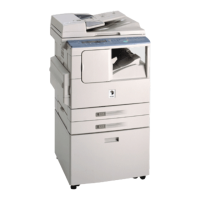CHAPTER 5 IMAGE FORMATION SYSTEM
COPYRIGHT
©
2002 CANON INC. 2000 CANON iR1600/iR2000 REV.1 JAN. 2002
5-9
4.2 Turning On and Off the Bias
The DC bias applied to the transfer charging roller may be a positive DC bias or a nega-
tive DC bias, each turned on or off as follows:
4.2.1 Turning On and Off the Positive DC Bias
When the transfer positive DC bias drive signal (TRPFOT*) goes ON and the constant
current/voltage switch signal (TRCHG) goes ‘1’, the positive DC bias is generated.
The output level of the DC bias is controlled by the transfer DC bias output level signal
(TRPWM*). The positive DC bias is used for image transfer.
4.2.2 Turning On and Off the Negative DC Bias
When the transfer negative DC bias drive signal (TRNFOT*) goes ON, the negative DC
bias is generated. The negative DC bias is used for the cleaning of the transfer charging
roller.
4.3 Controlling the Bias to a Constant Current /Voltage Level
The output level of the DC bias applied to the transfer charging roller is controlled as fol-
lows:
4.3.1 Controlling the DC Bias to a Constant Current Level
The internal resistance of the transfer charging roller changes because of variation among
parts and the changes occurring in the environment. When the positive DC bias drive signal
(TRPFOT*) goes ON and the constant current/voltage switch signal (TRCHG) goes ‘0’ dur-
ing initial rotation, a specific level of current is generated, and the CPU measures the volt-
age level with reference to the transfer charging roller voltage detection signal (TRCRNT)
to find out the changes in the internal resistance. It then corrects the DC bias based on the
result of detection.
4.3.2 Controlling the DC Bias to a Constant Level
The output level of the DC bias is detected by the developing DC bias voltage detection
circuit, and is fed back to the DC generation circuit by way of the comparison circuit. The
ASIC on the DC controller PCB then varies the pulse width of the primary/developing DC
bias output level signal to ensure that the DC bias is kept to a specific level.

